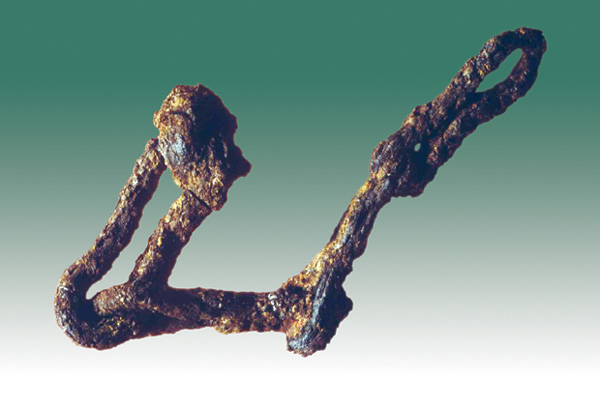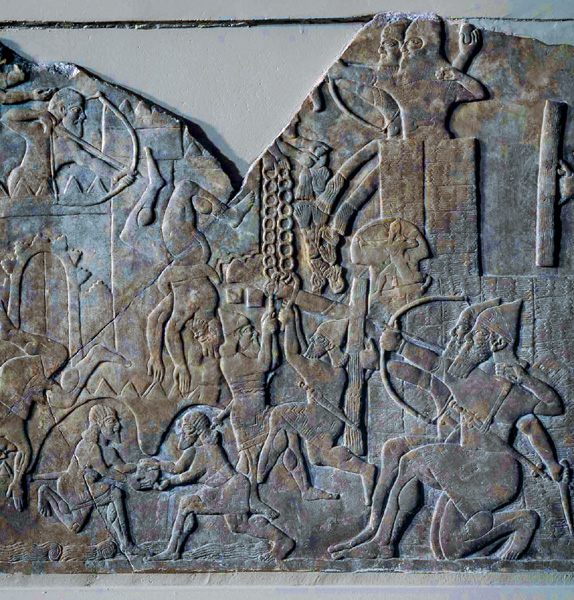040

Siege warfare was the most arduous and terrifying form of war in the ancient world. For the attacked, defeat threatened not only their warriors but their women and children. For the attackers, a siege meant long weeks in a filthy camp, short rations and backbreaking labor under extremely hazardous conditions. Massacre, enslavement and rape often followed a siege—as starved, angry troops sacked the city in a wild, bloody frenzy.
From the beginning, human beings have built fortifications to protect themselves from attack. Ancient Jericho built massive fortifications as early as 7000 B.C.E. The town’s defensive wall, 10 feet thick and 13 feet high, enclosed a settlement of perhaps 2,500 people. Even with primitive flint tools, the citizens of Jericho were able to hack a large moat out of the bedrock at the base of the wall to make access to the wall more difficult.
At about the same time, the residents of Catal Hoyuk in Turkey were building contiguous houses, so that the outer walls served as fortifications. These houses had no doors; people exited through a hole in the roof and moved about the city on the rooftops. If an enemy broke through the wall of a house, he found himself in a room with the defenders waiting for him on the roof.1
041
Mesopotamian engineers strengthened their walls with towers placed close enough together so that attackers approaching the wall would be caught in the cross fire of archers. Crenelated battlements protected the defenders atop the wall, and projecting balconies allowed them to shoot straight down on soldiers at the base of the wall.
The weakest point in a wall was the gate, and architects spared no effort trying to design secure gates. Entrances to the earliest fortified cities were usually winding and restricted, so that attackers who broke through found themselves in a narrow passageway. After the invention of the chariot in the second millennium B.C.E., double doors and accessible entranceways were necessary to allow chariots to move in and out of the city. A heavy horizontal beam reinforced such doors. Metal plating protected them from fire. Entranceways contained pilasters, bastions, towers and balconies to provide maximum protection at the weakest point.2
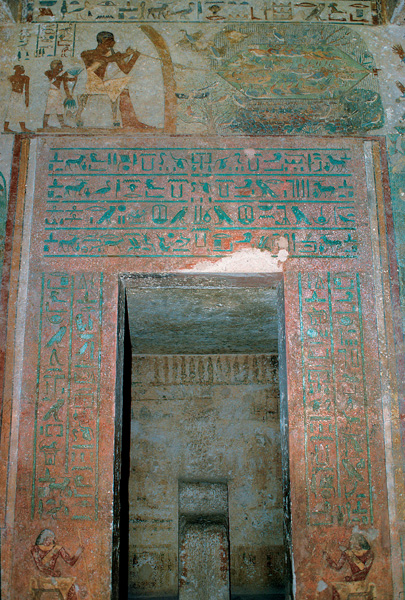
Our earliest evidence of siege techniques comes from Egyptian reliefs and wall paintings. A 24th-century B.C.E. relief in the tomb of Anta at Deshashe in Upper Egypt shows attacking soldiers attempting to pry 042open a gate with poles, while others scale the walls under the covering fire of archers. At Beni Hasan, about halfway between Memphis and Thebes, a 20th-century B.C.E. wall painting shows a primitive battering ram; three soldiers are moving toward a wall wielding a long pole to pry loose the bricks.
Cuneiform tablets from 18th-century B.C.E. Mari, on the upper Euphrates River, provide our earliest written evidence of siege warfare. In these tablets, the Assyrian king Ishme-Dagan reports using a variety of siege methods, though we have no pictures or descriptions of his machines. His rams were probably tools used by soldiers to pry bricks from a wall (as in the Beni Hasan relief). The siege towers mentioned in the tablets may have allowed soldiers to reach the top of a wall by walking across a plank reaching from the tower to the wall. Tall siege towers could also provide an excellent angle of fire for archers shooting at defenders on top of a wall.
Ishme-Dagan also refers to siege ramps, which allowed the attackers to deploy their rams against the upper part of a wall, where it was much thinner than at the base, which would have been about 80 feet thick. An Old Babylonian mathematical problem indicates that 9,500 men working 12 hours a day could build a ramp to the top of a 70-foot-high wall in five days. Archaeologists have discovered one such siege ramp at the Judahite city of Lachish, which the Assyrian king Sennacherib besieged in 701 B.C.E. Its gradient appears to have been about 30 degrees, and it was about 180 feet wide, enough to accommodate five rams.3

Finally, Ishme-Dagan’s army included sappers, who tunneled under a wall and then collapsed it by burning the wooden support beams that held up the roof of the tunnel. It was a ticklish business because if they dug too deeply, the wall would not collapse into the tunnel because the tunnel roof would be thick enough to support the weight of the wall; if they were too shallow, the weight of the wall might break the support beams, causing the wall to fall into the tunnel while the sappers were still in it.
The Neo-Assyrian Empire of the first millennium B.C.E. provides vivid images of ancient siege warfare. Assyrian kings not only maintained records of their military campaigns, but they also decorated their palaces with reliefs illustrating their conquests. The Assyrians deployed chariots, cavalry, infantry and archers in a tactically integrated army that could operate in all kinds of terrain over great distances.
The Assyrian military was most impressive, perhaps, in its ability to organize large-scale sieges—which were like giant construction (or destruction) projects. The Assyrians’ most spectacular weapon was the battering ram. King Ashurnasirpal II (883–859 B.C.E.) deployed heavy rams about 15 feet long and 10 feet high that required six wheels for support. A turret at the front provided protection for archers. A pole with a blade at the end hung from a rope. The crew forced the blade between the bricks of the wall and pried them out. Under Shalmaneser III (858–824 B.C.E.), the 043Assyrians deployed a four-wheeled model that may have been lighter and more mobile. Sennacherib (704–681 B.C.E.) lengthened the battering pole to provide more reach and leverage.
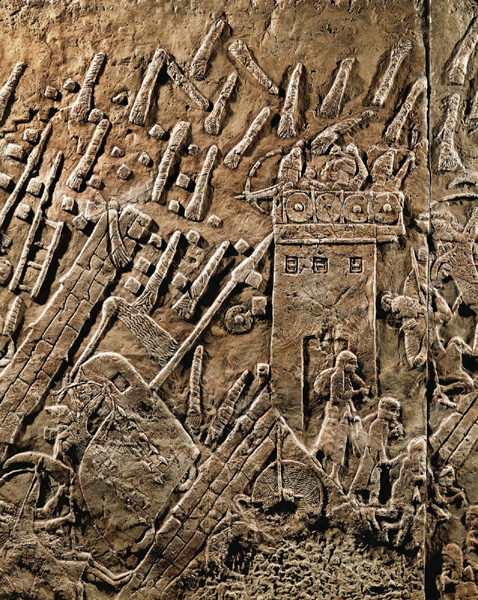
Assyrian palace reliefs show archers and lancers scaling walls while the rams are at work. The scalers wear short skirts to allow maximum leg movement, they carry small shields, and they mount the walls in overwhelming numbers. As the soldiers climb the walls, sappers work at the base of another wall, attempting to undermine it. The Assyrians used large curved wicker shields to protect their sappers. These shields, which were set against the walls, were sturdy enough to deflect stones dropped from the top of the wall.
Despite the Assyrians’ impressive assault methods, they could not breach a strongly fortified city—so 044they would try to isolate it from the outside world. As thirst is more powerful than hunger, the Assyrians would attempt to cut off the water supply of a city under siege. These so-called passive sieges could take a long time. Tiglath-pileser III (744–727 B.C.E.) required three years to conquer the city of Arpad (modern Tell Rifat, in Syria), and his successor Shalmaneser V (726–722 B.C.E.) also needed a three-year siege to capture Samaria.
Besieged cities showed incredible endurance. Ashurbanipal (668–627 B.C.E.) claimed that the Babylonians “ate each other’s flesh in their ravenous hunger” during his siege of their city. When Sennacherib was trying to negotiate the surrender of Jerusalem before commencing a siege, he threatened that the people of Jerusalem would be doomed to “eat their own dung and drink their own urine” (2 Kings 18:27). Thucydides, the most reliable historian of the ancient world, tells us that in 429 B.C.E. the people of the northern Greek city of Potidaea resorted to cannibalism near the end of a two-year siege by the Athenians.
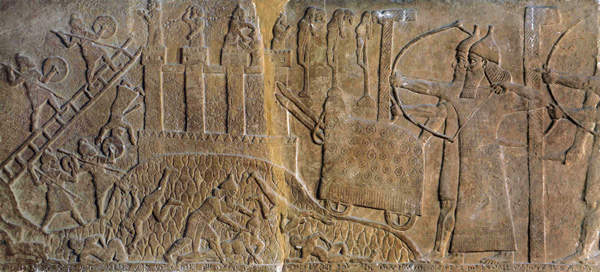
Cities held out for so long because a grim fate awaited them should they fall. Assyrian annals tell of impaling prisoners on stakes and cutting off their noses, ears and lips, and of skinning or burning prisoners alive and building mounds with the skulls. Assyrian reliefs show impaled prisoners, as well as prisoners who are staked to the ground and flayed by Assyrian soldiers. These texts and reliefs were found in the palace rooms where Assyrian kings received envoys from other cities—and they were thus grim reminders of what happened to those who resisted the Assyrians’ will.
Our first detailed view of a siege comes from Thucydides’s description of Sparta’s conquest of the Greek city of Plataea in 429 B.C.E. The Spartan commander, Archidamus, made every effort to avoid a long siege. First he tried to negotiate a surrender of the city by offering easy terms. Then he attempted to breach the wall by building a siege ramp and using rams. Finally, he attempted to set fire to the town. When all these tactics failed, he turned to a passive siege. The Spartans constructed a wall around Plataea to seal it off completely. They dug two concentric ditches around the town; between these ditches, they built a double mudbrick wall about a mile in circumference. The Spartans then built a roof over the walls, which were about 16 feet apart, and divided the interior space into rooms to quarter their troops. On top of the double wall, they built battlements, with a tower spanning the walls at every tenth battlement. The ditches served as moats, making access to the double wall difficult from both directions.
Although the Plataeans had evacuated most of their population before the siege, 480 men and 110 women were trapped in the town by the Spartan wall. During the second winter, 220 men escaped over the wall on a stormy night that kept the Spartan troops sheltered in their quarters. This reduced the number of mouths to feed; nonetheless, by the next summer the Plataeans’ food supplies were exhausted and they surrendered. The Spartans immediately killed all the male survivors and sold the women into slavery.
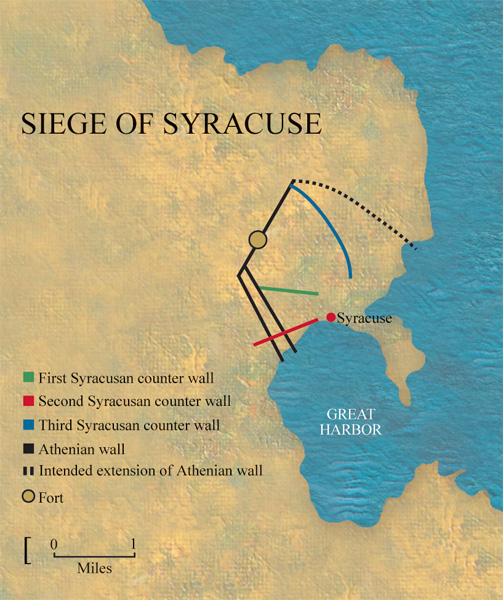
Often, however, sieges failed. The greatest disaster occurred in Sicily during the Peloponnesian War when the Athenian siege of Syracuse collapsed.4 The Athenians had arrived in Sicily with a powerful force of 134 ships, 5,100 heavy infantry, 480 archers and 700 spear-slingers. Athens’s strategy was to force Syracuse to surrender by cutting it off from the outside world by land and sea. The siege began successfully enough as the Athenians gained control of a high plateau above 045the city, which made it possible for them to begin building a wall to seal Syracuse off from the interior. After a failed attack on the new Athenian wall, the Syracusans decided to build a counter wall to intersect the path of the Athenian wall and prevent its completion. Since the Athenians controlled the high plateau, however, the Syracusans were forced to build their counter wall on low, swampy ground south of the plateau. They made two efforts to extend a counter wall far enough to cut off the southern portion of the Athenian wall, but the Athenians destroyed both of these counter walls and then extended their own wall southward, almost to the sea. But progress on the northern portion of the wall had lagged. When reinforcements from Sparta arrived at Syracuse, they were able to get through the Athenian blockade by both land and sea because the northern wall that would have closed off the city had not been completed and the Athenian naval blockade was not maintained with sufficient vigilance.
The Syracusans then managed to capture a fort on the plateau that guarded the Athenian supply line. This forced the Athenians to move their center of operations south of the plateau to the low and swampy terrain along the shore of Syracuse’s harbor. It also allowed the Syracusans to build a third counter wall on the plateau, preventing the Athenians from finishing the northern course of the enclosure wall.
The Athenian failure to complete the northern portion of their siege wall before reinforcements from Sparta arrived was inexcusable. Modern historians have placed most of the blame on Nicias, the Athenian commander. Nicias, who was suffering from a painful illness, lacked confidence in Athens’s ability to reduce Syracuse by siege and counted on the possibility that certain Syracusans would betray their city. This was by no means far-fetched; sieges placed tremendous pressure on cities and often split them along their social fault lines. Indeed, a defeatist faction was active in Syracuse, and Nicias was apparently in touch with it. Given his precarious logistical position, Nicias’s judgment that betrayal was a more promising avenue to victory than a long siege may well have been sound.
Nicias nonetheless deserves the opprobrium that has been heaped upon him, not because he failed to take Syracuse but because he failed to extricate his army from a failed siege. At his request, Athens sent large reinforcements under the command of Demosthenes, a much more aggressive general. In order to recapture the initiative, Demosthenes led a daring nighttime attack 046to try to recapture the plateau. When the attack failed, Demosthenes concluded that the Athenian position was untenable and recommended withdrawal. Disease, the bane of siege armies, had ravaged the Athenian troops, who were now confined to the unhealthy swampy lowland. Despite the desperateness of the situation, Nicias delayed because he feared punishment by the Athenian people if he returned unsuccessful. When he finally decided to evacuate his army, an eclipse of the moon convinced him that the moment was inauspicious for departure. The further delay enabled the Syracusans to blockade the harbor. When the Athenian navy tried to break the blockade, the Syracusans won a great naval battle, sealing the fate of the Athenian expedition. The tattered remains of the Athenian troops attempted a retreat by land, but they were slaughtered by the Syracusans. Nicias and Demosthenes were both put to death, and the survivors were imprisoned in a quarry where most of them died. “Few out of many came back home,” wrote Thucydides, laconically.
If the Athenian debacle at Syracuse was the greatest failure in ancient siege warfare, Alexander the Great’s siege of Phoenician Tyre in 332 B.C.E. was perhaps the greatest success.5 A heavily fortified island city, Tyre had long been considered impregnable. Alexander knew the siege would be long, so his first task was to establish a strong logistical position. Fortunately, there was an adequate water supply on the small coastal plain opposite the city, but it was not large enough to provide enough food. Alexander had to establish a sea route and an overland supply route from Palestine to keep his army fed.
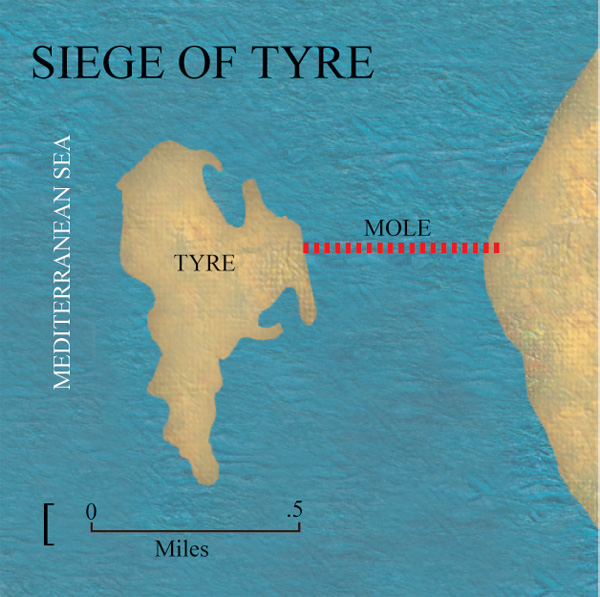
Having secured his supply routes, Alexander’s next task was to gain access to the island city. This required the construction of a mole (a wood, mud and stone breakwater) to bridge the half-mile-wide channel that separated Tyre from the mainland. Alexander raised the necessary labor by putting his own soldiers to work and by pressing local inhabitants into labor gangs. He personally directed the work and offered large gifts as incentives to keep his soldiers to the task.
The work progressed despite fierce opposition from the Tyrians. Rough surf constantly smashed against the mole, and a severe storm destroyed a good part of it. Despite these obstacles, Alexander’s men finally connected the island city to the mainland by a kind of stone highway. Now Alexander could move his siege machinery over the mole and attack the walls of Tyre.

047
Alexander’s siege machinery included catapults, which had been invented in Syracuse earlier in the fourth century B.C.E. The earliest kind of catapult was an arrow-shooting device similar to a crossbow. By Alexander’s day, torsion-powered catapults had become strong enough to sling stones. We do not know the exact design of these catapults, but they relied on the energy pent up in cords tightly twisted by a winch. A sudden release of the tension in the twisted cords caused the arm of the catapult to spring forward with tremendous force. During Demetrius the Besieger’s siege of Rhodes in 305 B.C.E., the women of Rhodes cut their long hair to provide fibers for the Rhodian torsion catapults. Alexander had both arrow-shooting and stone-throwing catapults—both of which were anti-personnel weapons, not wall breakers.
The mole afforded Alexander’s Macedonian army only a narrow space to attack Tyre’s wall. The Tyrians reinforced their already strong fortifications at the point of attack by building a 15-foot-thick wall 7 feet behind the outer wall and filling in the space with rocks and dirt. They also raised the height of the wall 061to maintain an advantage over the Macedonian siege towers. Alexander’s men tried to cross the Tyrian wall over bridges attached to their siege towers, but the Tyrians repulsed them by throwing nets over the bridges, pulling the Macedonians off and pouring hot sand on them. The hot sand was extremely painful when it worked its way under the armor of the Macedonian soldiers.
Discouraged enough to consider breaking off the siege, Alexander tried a last tactic: deploying ram-bearing ships against the Tyrian walls to escape the restricted space at the end of the mole. The Macedonians anchored their ships close to the wall and, after much probing, achieved a partial breach on the southern side of the city.
Breaching a wall, however, did not guarantee the fall of a city. The breach left a pile of rubble over which attackers had to climb to get into the city. Alexander exploited the breach by mounting multiple attacks all around the city to prevent the Tyrians from concentrating all of their defenders at the breach. He brought a ship up to the breach, dropped a gangplank over it and personally led his elite infantry into the city. The first officer to cross the breach was killed, but Alexander, following right behind his slain lieutenant, managed to capture both the breach and the adjacent sections of the wall. At about the same time, another contingent of soldiers also broke into the city, presumably by scaling the wall, and Tyre’s defenses crumbled.
A horrible massacre followed. Before the battle, the Tyrians had killed Macedonian heralds, who were considered sacrosanct in the ancient world, and during the siege they had butchered some prisoners on the wall in sight of the Macedonians. Infuriated, the Macedonians went on a killing spree. In retribution for the killing of the heralds, Alexander ordered two thousand Tyrians crucified. He spared only a few Tyrians who had found refuge in a temple, as well as some women and children; these survivors were sold into slavery.
The Macedonian plundering of Tyre was a typical consequence of siege warfare. Maintaining discipline in the midst of a sack was difficult; a wild frenzy often seized the troops, who no longer were restrained by traditional taboos, such as prohibitions against the rape and murder of children. The codes of honor that generally governed warriors’ conduct often collapsed with the walls of the city.
According to the ancient Hebrew prophets and the Greek tragic playwrights, siege warfare produced three principal horrors: rape, baby killing, and splitting open the wombs of pregnant women. Such terrors suggest a morally chaotic world without limits or structure. Thucydides called war a harsh master because it reduced men to an elemental level in which survival was the only goal. Siege warfare was the harshest master of all.
Siege warfare was the most arduous and terrifying form of war in the ancient world. For the attacked, defeat threatened not only their warriors but their women and children. For the attackers, a siege meant long weeks in a filthy camp, short rations and backbreaking labor under extremely hazardous conditions. Massacre, enslavement and rape often followed a siege—as starved, angry troops sacked the city in a wild, bloody frenzy. From the beginning, human beings have built fortifications to protect themselves from attack. Ancient Jericho built massive fortifications as early as 7000 B.C.E. The town’s defensive wall, 10 feet thick […]
You have already read your free article for this month. Please join the BAS Library or become an All Access member of BAS to gain full access to this article and so much more.
Already a library member? Log in here.
Institution user? Log in with your IP address or Username
Endnotes
For the earliest fortifications, see Lawrence H. Keeley, War Before Civilization (New York: Oxford University Press, 1996), and Arther Ferrill, The Origins of War (London: Thames and Hudson, 1985). For siege warfare in biblical times, see Yigael Yadin, The Art of Warfare in Biblical Lands in the Light of Archaeological Discovery (London: McGraw-Hill, 1963).
Good examples of early gates can be found at Abydos in Egypt (29th century B.C.E.) and at Troy II (early third millennium B.C.E.). See Alexander Badawy, Architecture in Ancient Egypt and the Near East (Cambridge: MIT Press, 1966), p. 57; and Yadin, Warfare in Biblical Lands, p. 57.
See David Ussishkin, The Conquest of Lachish by Sennacherib (Tel Aviv: Tel Aviv Univ. Institute of Archaeology, 1982), for a description of the remarkable archaeological evidence of the siege of Lachish.
See Thucydides’s Peloponnesian War, books 6 and 7, for his famous narrative of the Sicilian expedition.

